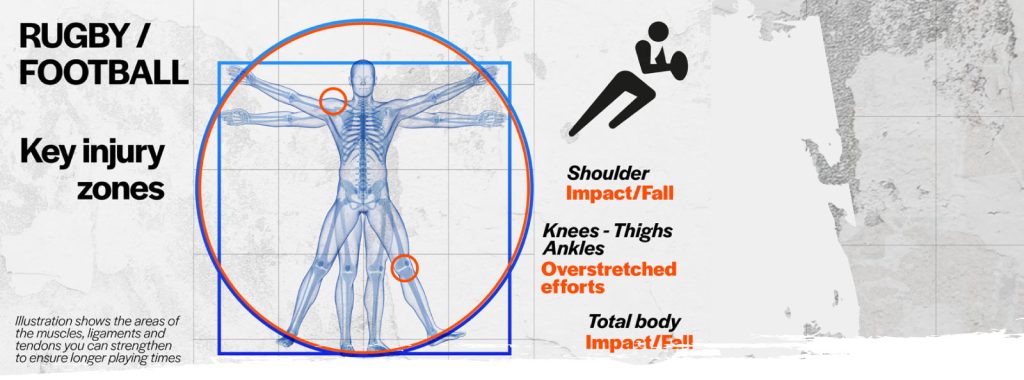American football (we’ll just call it football from now) and rugby have different sets of rules, different strategies and different fan-bases. But they share origins going back a couple of hundred years, with the British game brought to the US by immigrants.
Both rugby and football require an unrivalled mix of strength and stamina, combined with an almost superhuman grit necessary to withstand continuous high-impact, almost brutal, collisions. It is absolutely amazing how a football/rugby player can sustain 60/80 minutes of all of it.
The injury profile is very similar too*. It should be mentioned that rugby presents more overall risk of injury than football, and that both carry a higher risk than pretty much any other common team sport.
We’re going to take a look now at what these injury areas are, and even more importantly what we need to do to prepare ourselves to come back stronger!
Impact injuries
Let’s get this out of the way first. The violence and the frequency of the impacts make bruising, concussions and fractures very common. It is the nature of these sports. Even though we can’t directly prevent it, strength, cardiovascular fitness and flexibility help immensely to reduce risks**. Here’s briefly how: If you are stronger, you can withstand collisions better by absorbing impact through sturdy muscles and not joints/bones; better fitness makes you recover faster on the pitch and keeps you way more focused; improved flexibility (very often neglected) makes your joints work at every angle and range comfortably, ready to deal with every situation.
Lower body strains
Not to be confused with sprains, strains affect the tendons (strings that attach muscles to bones). They most likely occur when the muscle is requested to produce a sudden effort outside a comfortable range of motion***. You know how hectic a game can be sometimes. And when in action, you are not in perfect control of how, for example stretched your arms are, or how your ankle is positioned, etc. It is easy to spot how stretching is absolutely vital to make joints and muscles at ease in working at every range. Common lower body strains are Achilles tendon, hamstrings and quadriceps (thigh).
Shoulder dislocation
I’ve shared a personal horror story about basketball on an earlier blog. A shoulder dislocates when the bone in the upper arm (humerus) slips out of the socket that holds it (glenohumeral joint). Contrarily to basketball (and partially tennis), rugby/football dislocation are almost entirely due to impacts and not to an active movement of the arm****. It is relatively uncommon in everyday life, since the various layered mechanisms that keep the shoulder in place are pretty strong. But a rugby/football player must make sure to prepare properly.
Don’t worry, though, here is a bunch of exercises which can make all of the above a lot less likely to happen!
EXERCISES
Get stronger
Improve your strength
to withstand impacts with this push-up challenge.
1 push-up – 1 second plank hold, into
2 push-up – 2 seconds plank hold into
3 push-up – 3 seconds plank hold and so on… See how far you can get!
Make sure you keep your body in a very straight and strong line! No bending at any time. Remember, push-ups are very hard, so if you are still not quite there, no worries: find a higher surface to put your hands on, and do them from an inclined position!

Calf stretch
Find a step, and slide half of one foot back so the heel is hanging off. Put some of your body weight on it (you decide how much) until discomfort but not pain. Hold it for 45 seconds, 3 times each leg.

Hamstring stretch
Place your feet wide (very wide) and your hands flat down on the ground. If you feel you need to bend the knees, or if your hands don’t fully rest on the floor, adjust your stance a little wider and try again. Hold it for 60 seconds, three times.

Quadriceps/hip flexors stretch
In a lunge position, grab your foot with your hand or with an elastic band. Try to keep your chest nice and high, and push your hips through (forward). It is quite challenging, so build up slowly to it. Hold 5 times each leg for 20 seconds.
left ankle should be parallel with knee

Shoulder stretch
Place a stick/broomstick/pvc pipe behind your neck, with a very wide grip. Then, squat down, and from there push the stick up and down, from relaxed on your shoulder to arms straight. Make sure the stick ends right above your head (neither forward nor back). 10 repetitions, 3 sets.

References
*Willigenburg, N. W., Borchers, J. R., Quincy, R. Kaeding, C. C. , Hewett, T E. (2016) ‘Comparison of injuries in American football and club rugby – a prospective cohort study.’ The American journal of sports medicine, 44(4), 753-762
**Ratamess, N. (2012) Foundations of Strength training and Conditioning. Indianapolis: Lippincott, Williams and Wilkins
***Ogawa, T., Fukano, M., Fukubayashi, T. (2015) Sports injuries and prevention. 1st edition. Saitama: Springer.
****Hutson, M., Speed, C. (2011) Sports Injuries. 1st edition. Oxford: Oxford Press.






